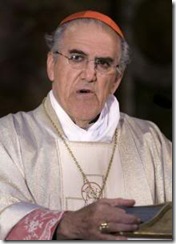The official Catholic view about sex is a huge topic and far beyond the scope of a blog post. Yet, there are a number of news items or blog posts flying about cyberspace that are worthy of comment.
Celibate priesthood:
A December 3 post in Catholicism in the 21st Century blog contains a link to the Futurechurch website and the announcement of a new initiative: Optional Celibacy: So All Can Be At the Table.
We are launching an international electronic and paper postcard campaign asking Cardinal Hummes at the Congregation for the Clergy in Rome to open discussion of optional celibacy at the highest levels of the Church. We will also approach national bishops conferences, priest organizations and international reform groups for support in requesting discussion of changing celibacy rules to include both a married and celibate priesthood in the Latin rite of the Roman Catholic Church.
Although the Vatican’s recent invitation to disaffected Anglicans to join Roman Catholicism has been widely dissed as rank sheep stealing (see my posts here and here), does it not open the door a wee bit to married clergy? If the Vatican is willing to accept married Anglican priests en masse, should they not also be more considerate of in-house proposals for a married priesthood?
As an aside, another recent article in Catholicism in the 21st Century blog is rather juicy, entitled “In the Catholic Church it is men who tell women how they should understand themselves as women.”
Gays will never go to heaven:
 “Transsexuals and homosexuals will never enter the kingdom of heaven and it is not me who says this, but Saint Paul,” said Cardinal Javier Lozano Barragan, a Mexican cardinal and emeritus president of the Pontifical Council for Pastoral Health (1996-2009).
“Transsexuals and homosexuals will never enter the kingdom of heaven and it is not me who says this, but Saint Paul,” said Cardinal Javier Lozano Barragan, a Mexican cardinal and emeritus president of the Pontifical Council for Pastoral Health (1996-2009).
On this one, at least, the Vatican quickly issued a correction to Cardinal Barragan’s views. Catholic blogger James Martin in America Magazine, the national Catholic weekly, quotes a Vatican spokesman, Father Lombardi:
“It would be better, for example, to refer to the Catechism of the Catholic Church, which does talk about homosexual acts as ‘disordered,’ but takes into account the fact that ‘the number of men and women who have deep-seated homosexual tendencies is not negligible, ‘” Father Lombardi wrote. Homosexuals “must be welcomed with respect and sensitivity, and ‘every sign of unjust discrimination in their regard should be avoided,'” he wrote, quoting the catechism.
“Disordered,” yes. Go straight to hell, no. At least it’s something. Or, is it?
The Queering the Church blog quotes gay theologian James Alison:
The experience of many gay people is that the Church in some way or other, kills us. Typically in official discourse we are a “they”, dangerous people whose most notable characteristic is not a shared humanity, but a tendency to commit acts considered to be gravely objectively disordered. Typically our inclusion within the structure of church life comes at a very high price: that of agreeing not to speak honestly … The message is: you’re fine just so long as you don’t rock the boat through talking too frankly, which is the same as saying “you’re protected while you play the game our way, but the moment that something “comes to light”, you’re out.
In this the non-explicit message of the ecclesiastical mechanism is exactly the reverse of the explicit message of the Church. The explicit message is: God loves you just as you are, and it is from where you are that you are invited to prepare with us the banquet of the kingdom. The latent message is: God loves you as long as you hide what you are and deny yourself the search for the integrity and transparency of life and of virtues which it is your task to teach to others.”
Sex Abuse saga continues:
Just as the American Catholic church puts a few years behind the height of the clergy abuse scandal, the Dublin Archdiocese Commission report hits the news, and the scab is pricked anew. Journey to a New Pentecost blog offers the following quote from the report:
The Commission has no doubt that clerical child sexual abuse was covered up by the Archdiocese of Dublin and other Church authorities over much of the period covered by the Commission’s remit. The structures and rules of the Catholic Church facilitated that cover-up. The State authorities facilitated the cover up by not fulfilling their responsibilities to ensure that the law was applied equally to all and allowing the Church institutions to be beyond the reach of the normal law enforcement processes. The welfare of children, which should have been the first priority, was not even a factor to be considered in the early stages. Instead the focus was on the avoidance of scandal and the preservation of the good name, status and assets of the institution and of what the institution regarded as its most important members – the priests. In the mid 1990s, a light began to be shone on the scandal and the cover up. Gradually, the story has unfolded. It is the responsibility of the State to ensure that no similar institutional immunity is ever allowed to occur again. This can be ensured only if all institutions are open to scrutiny and not accorded an exempted status by any organs of the State.
With this report from Ireland, it is worth repeating that a preliminary report to the American Council of Bishops issued just a few weeks ago suggests that the reasons for child sexual abuse are unrelated to gay-straight issues.
Because this post is already long, it will not consider women’s ordination or the Vatican clampdown on nuns in America. But it could. It all comes down to sexuality.
Is the Roman Catholic hierarchy pathologically disordered?
The Catholic catechism calls gays “disordered”. Is the finger pointing in the wrong direction?
A hard hitting op-ed piece appearing in today’s Irish Times, entitled Papal Princes immune to censure, thinks so:
The Catholic Church’s hypocrisy starts right at the top of the organisation, writes JASON BERRY
THE DUBLIN diocesan report spotlights the crisis tearing at the Catholic Church’s central nervous system. At issue is the Vatican’s pathological obsession with protecting guilty church officials.
The Vatican ignores justice to protect bishops in their role as regents to the pope.
Finally, in another Irish Times op-ed, quoted here from The Progressive Catholic Voice blog, clinical psychologist Maureen Gaffney goes right to the heart of the matter. In what strikes me as an Irish woman daring to shout that the papal emperor wears no clothes, Gaffney suggests that the fundamental problem is that the Catholic church is stuck in an antiquated and destructive view of human sexuality that leads to negative outcomes for each of the issues addressed here.
That will require the church to face up to a much more profound problem – the church’s own teaching on sexuality.
Consider the list of issues the church has failed to deal with credibly since the 1960s: premarital and extramarital sex; remarriage; contraception; divorce; homosexuality; the role of women in ministry and women’s ordination; and the celibacy of the clergy. All have to do with sexuality.
Very few Catholics are looking to the church for moral guidelines in relation to any of these questions anymore. And why would they? After all, the church’s teaching on sexuality continues to insist that all intentionally sought sexual pleasure outside marriage is gravely sinful, and that every act of sexual intercourse within marriage must remain open to the transmission of life. The last pope, and most probably the present, took the view that intercourse, even in marriage, is not only “incomplete”, but even ceases to be an act of love, if contraception is used. Such pronouncements are so much at variance with the lived experience of most people as to undermine terminally the church’s credibility in the area of intimate relationships.
[The church] must confront the root cause of the problem – that the Catholic Church is a powerful homo-social institution, where men are submissive to a hierarchical authority and where women are incidental and dispensable. It’s the purest form of a male hierarchy, reflected in the striking fact that we all collectively refer it to as “the Hierarchy.”
It has all the characteristics of the worst kind of such an institution: rigid in social structure; preoccupied by power; ruthless in suppressing internal dissent; in thrall to status, titles, and insignia, with an accompanying culture of narcissism and entitlement; and at a great psychological distance from human intimacy and suffering.
Most strikingly, it is a culture which is fearful and disdainful of women. As theologian William M Shea observes, “fear of women, and perhaps hatred of them, may well be just what we have to work out of the Catholic system”. Until that institutional misogyny is confronted, the church will be unable to confront the unresolved issue of its teaching on sexuality and the sexuality of the clergy. Instead, celibacy will continue to be used as a prop to the dysfunctional homo-social hierarchy. The hierarchy will continue to project its fear of women on to an obsessive effort to exert control over their wombs, their fertility and their unruly sexual desires. That is the psychology of exclusion.

 Sister of Charity Louise Akers filled in for scheduled keynoter Roy Bourgeois Friday evening because Bourgeois’ father took ill.
Sister of Charity Louise Akers filled in for scheduled keynoter Roy Bourgeois Friday evening because Bourgeois’ father took ill. 